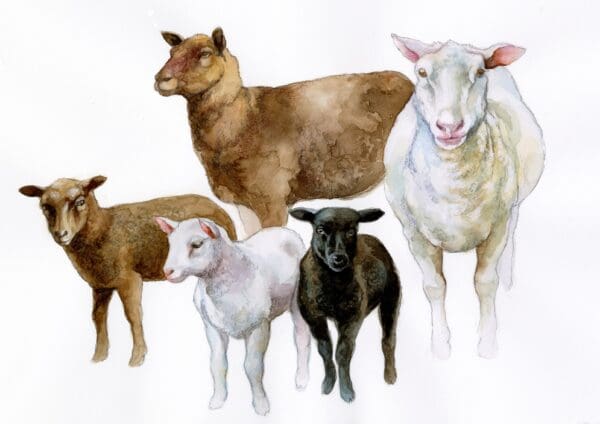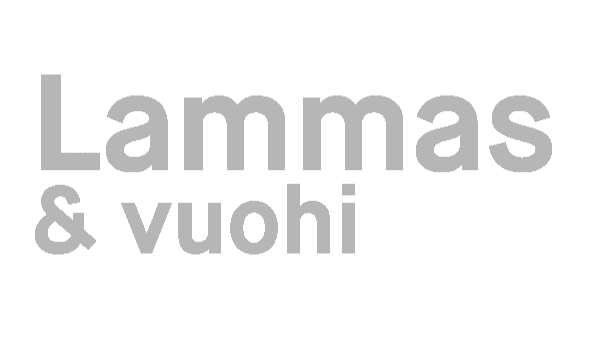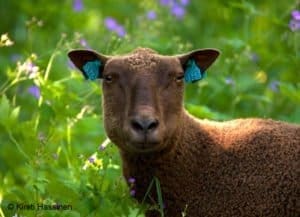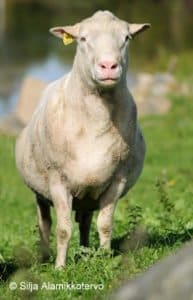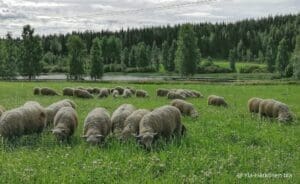Finnsheep

The early ancestors of this Finnish landrace breed arrived in Finland during the transitional period between the Neolithic period and Bronze Age, nearly 4000 years ago. The Finnsheep shares a large amount of ancestral genetic material with other North European short-tailed breeds and has developed without interbreeding with more recently introduced breeds. It is the most common breed of sheep in Finland; according to animal recording data, 11,597 purebred Finnsheep ewes lambed in the year 2023.
Our beautiful and precious national breed
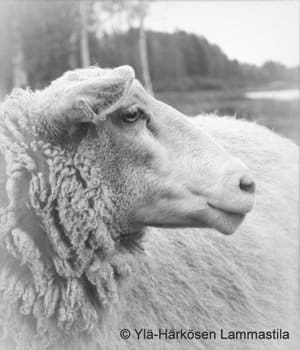 Finnsheep is a medium-sized, polled solid-colored breed. Adult weight averages 85 to 105 kg for rams and 65 to 75 kg for ewes. White is the most common color; black, brown and grey individuals also exist, with grey being the rarest. The smooth guard hairs on the head and legs are the same colour as the wool, and the head sometimes has woolly “forelocks.” The Finnsheep is lively, alert, friendly and easy to handle, and has a very strong herd instinct.
Finnsheep is a medium-sized, polled solid-colored breed. Adult weight averages 85 to 105 kg for rams and 65 to 75 kg for ewes. White is the most common color; black, brown and grey individuals also exist, with grey being the rarest. The smooth guard hairs on the head and legs are the same colour as the wool, and the head sometimes has woolly “forelocks.” The Finnsheep is lively, alert, friendly and easy to handle, and has a very strong herd instinct.
Finnsheep wool is typically medium fine. While the breed’s wool consists primarily of ground hair it can contain a small amount of guard hair. Finnsheep wool is highly regarded for use in arts and crafts and is shiny, flexible, soft and has good felting properties. The average adult sheep produces approximately three kilograms of wool per shearing. The Finnsheep’s natural colour range is wide, giving many opportunities for blending different hues together.
Finnsheep pelts are soft, shiny and durable, and available in many different types of wool. The hide is single-layered, allowing leather to be worked very thin and ensuring that the hair remains well attached.
Superior fertility
The Finnsheep’s reproductive capabilities are unique. Finnsheep ewes become fertile at the age of 7 to 8 months and weight of 50 kg. Fertilisation is not dependent on seasons. A large number of egg cells are released on ovulation and probability of fertilisation is high.
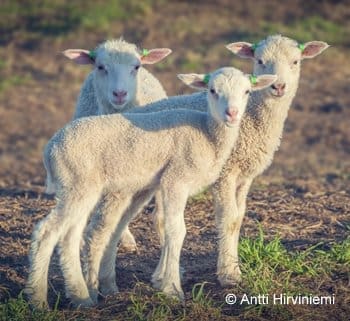 Finnsheep ewe has a large uterine capacity that adjusts to support multiple healthy fetuses. Of Finnsheep pregnancies 10% are single, 40% each twins and triplets, 10% quadruplets and 2% quintuplets. As litter sizes are large and the ewe remains fertile for a long time, maintenance costs relative to production by total weight of lambs are low. Since lambing more than once per year is possible, lambs can be produced year round. The Finnsheep’s mothering ability is good and milk production capability is sufficient.
Finnsheep ewe has a large uterine capacity that adjusts to support multiple healthy fetuses. Of Finnsheep pregnancies 10% are single, 40% each twins and triplets, 10% quadruplets and 2% quintuplets. As litter sizes are large and the ewe remains fertile for a long time, maintenance costs relative to production by total weight of lambs are low. Since lambing more than once per year is possible, lambs can be produced year round. The Finnsheep’s mothering ability is good and milk production capability is sufficient.
Finnsheep rams are very active and become fertile at four months of age. Adult rams’ fertilisation ability and sperm quality are good, and testicle weight to total body weight ratio is higher than in other sheep breeds.
Due to their excellent fertility, Finnsheep have been exported to over sixty countries, both as live animals an as sperm. In recent years, exports have been increasing. The exported animals are primarily used for crossbreeding to increase the fertility of local breeds.
High quality meat all year round
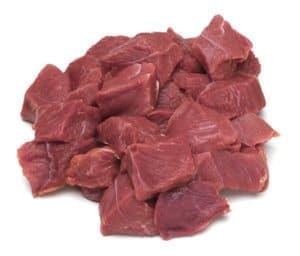 Finnsheep is well suited for both organic and high-yield production. Since tendency towards fattening is low, a large proportion of concentrated feed can be used to attain slaughter weight at the age of five and a half months, with an average growth rate of 350 grams per day. This yields a 25 kg slaughter weight with an EUROP grading of O2.
Finnsheep is well suited for both organic and high-yield production. Since tendency towards fattening is low, a large proportion of concentrated feed can be used to attain slaughter weight at the age of five and a half months, with an average growth rate of 350 grams per day. This yields a 25 kg slaughter weight with an EUROP grading of O2.
The Finnsheep’s good ability to process roughage supports the animal’s natural behaviour as well as productivity. Fat is concentrated around the internal organs, making it easy to remove. Finnsheep-based production makes it possible to offer fresh lamb for the market year round. The meat is low in fat, fine-grained and tender, with a mild flavour.
An effective landscaper
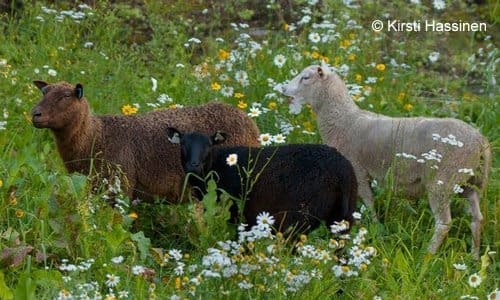 Finnsheep is well suited for landscaping service, including pasturing, clearing away thickets, and environmental management. Finnsheep browse eagerly on forest undergrowth and the leaves and shoots of trees and bushes. This makes it well suited for use in may kinds of areas such as forests, pasturage, and park-like environments. On natural pasture land it is a more effective grazer than most more extensively developed breeds.
Finnsheep is well suited for landscaping service, including pasturing, clearing away thickets, and environmental management. Finnsheep browse eagerly on forest undergrowth and the leaves and shoots of trees and bushes. This makes it well suited for use in may kinds of areas such as forests, pasturage, and park-like environments. On natural pasture land it is a more effective grazer than most more extensively developed breeds.
The use of Finnsheep supports the preservation of Finnish landrace breeds. It, the Åland sheep, and the Kainuu Grey are all sheep breeds eligible for government support for the raising of landrace animals. This form of government support has been paid out for farmers raising landrace breeds since the year 1995.
Breeding goals
The breeding of Finnsheep aims to preserve the breed’s good fertility, meat and wool qualities to meet the demands of the industry and consumers. For this purpose, the following characteristics are monitored: fertility, mothering ability, growth rate, carcass characteristics, health, build, amount and quality of wool, and the quality of pelts. Additionally, colour variations and existing ram genetic lines are to be preserved.
There are 73 Finnsheep genetic lines. These include 11 ewe lines with no extant rams. According to current data 44 ram lines are active, though a few of them have only one living ram or there is a lack of current data.
Link to recorded data about Finnsheep ram lines, updated 2023 >
In 1918, Suomen Lammas- ja Vuohenhoitoyhdistys (Finnish sheep and goat breeders association, later renamed to Suomen Lammasyhdistys, Finnish Sheep Breeders Association) started active breeding of the Finnsheep. Evaluations and maintenance of flockbooks began in 1922, with detailed recording starting later.
Directives for the Finnsheep flockbook >
Breeding guide for Finnsheep >
The development of muscularity in the Finnsheep population >, presentation in World Conference on Sheep in 2016
Qualified Breeding Farms in 2024
Pirjo and Hannu Iso-Junno, (black), Kivipellon tila
Tony and Kati Kajander (brown and black), Perkkiön tila
Lihasulan kartano (white) Lihasulan kartano
Ann-Mari Lintunen, (brown), Mäenkoikkalan tila
Juha Koro and Nina Snellman (white), Ylä-Härkösen tila
Pia and Anssi Parikka (white), Parikan tila
Pasi Aholaita ja Satu Alajoki (brown), Aholaidan tila
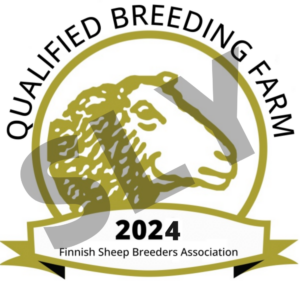
Breed association
Click the photos to enlarge:
- Luonnonniityllä riittää monipuolista ravintoa
- Jämäkkä suomenlammaspässi
- Slaughter lambs
More information here >

